Picasso loved the magic of illusionism—but here, he shatters it.
Pablo Picasso, Les Demoiselles d’Avignon, 1907, oil on canvas, 243.9 x 233.7 cm (The Museum of Modern Art, New York). Speakers: Dr. Beth Harris and Dr. Steven Zucker
[0:00] [music]
Dr. Steven Zucker: [0:06] We’re on the 5th floor of The Museum of Modern Art, looking at “Demoiselles d’Avignon,” by Pablo Picasso.
Dr. Beth Harris: [0:12] Picasso is a Spanish artist, but he’s in Paris when he paints this. The title translates to, “Young Ladies of Avignon.”
Dr. Zucker: [0:21] Which refers to a street that’s not in France, but is in Barcelona, and associated with prostitution.
[0:26] What we’re looking at is a brothel, the idea of rendering a woman who is available to the male viewer, but within a context that goes back to Degas. It also goes back to Manet, if you think about his painting “Olympia.” You could go even further back to the Venetian Renaissance and look at paintings by Titian.
Dr. Harris: [0:43] For many art historians, this painting is seen as a break with the 500 years of European painting that begins with the Renaissance.
Dr. Zucker: [0:52] Many art historians see this as the foundation on which Cubism is built.
Dr. Harris: [0:57] It’s this radical break that points to the future. It’s a radical break with these conventions of representation that had for so long been accepted in the West, about how you make a body in space, how you create a space. All of that is upended by “Les Demoiselles d’Avignon.”
Dr. Zucker: [1:13] Gone is linear perspective. Gone is chiaroscuro, that modulation of light and shadow that creates the illusion that Picasso, by the way, was in love with, the magic of illusion, but here he’s shattering it.
Dr. Harris: [1:26] He found the formal means to convey the ideas that were behind “Les Demoiselles d’Avignon.” Ideas about sexuality, about the female nude, about sexually transmitted diseases. This is a confrontational painting.
Dr. Zucker: [1:41] In the original sketches, the women were focusing on a male that was included, a sailor. There was also a medical student. He takes those men out, and the women then turn their gaze outward, like Manet’s “Olympia,” to engage us, the viewer, directly.
Dr. Harris: [1:55] Those two male figures give us a clue to some of the ideas behind the painting. A sailor, someone who’s in a brothel as a customer, who was seated at a table originally.
Dr. Zucker: [2:06] Then the medical student takes on a more analytical view, who looks at the women from a more scientific perspective, but also maybe from a more artistic perspective.
[2:15] Artists have a history of dissecting human bodies, of understanding the bone structure, the musculature, of looking at the body analytically.
Dr. Harris: [2:24] Let’s not forget that that medical student carried, at least in some sketches, a skull. Of course, it makes sense that a medical student studying anatomy might be carrying something related to his profession to tell us who he is.
[2:37] On the other hand, the skull in art history is a reminder of death. It’s a memento mori.
[2:43] There seems to be some tension here between the sensuality that the sailor is indulging in and a moralizing reminder that the pleasures of life are short, indicated by the skull carried by the medical student.
Dr. Zucker: [2:57] The faces of the women on the right are often seen as representations of African masks that we know Picasso was then looking at. The figure on the left is an archaic figure, going back to ancient Spain, going back to Iberian art before the classical period.
Dr. Harris: [3:11] That’s one of the problems of this painting. We look at art and we expect stylistic coherence, but here, we have this agglomeration of styles.
Dr. Zucker: [3:20] It’s a kind of invention. Picasso is allowing his laboratory to be exposed to us. There is a physical confrontation, there is danger here.
Dr. Harris: [3:28] The figures are really close to us. Space has become [these] palpable three-dimensional fractured planes.
Dr. Zucker: [3:36] The curtains that seem to thread in between the figures are pressed right up against those figures. There is no space behind or between. There is still some sense of illusion. There’s still some shadow. There’s still some highlighting. But Picasso has only created an illusion that goes back into space a few inches.
[3:52] It’s a little bit difficult to look at this painting without the hindsight of understanding where Cubism is going to go.
[3:58] Knowing that Cubism is this deconstruction of three-dimensional form, shattering that form and then placing those fragments back on a two-dimensional surface, has led some art historians to look at the central figure as one that we’re both looking across at, but also looking down at as if we’re standing over her while she lies on a bed.
[4:19] These were not ideas that Picasso came up with independently. Matisse had been exploring these ideas, and before him, Cézanne had done this.
Dr. Harris: [4:26] You can see why artists who saw this painting in Picasso’s studio soon after it was painted were horrified. [laughs] Even Degas, when he represented unidealized women in a brothel, never came close to the rawness, the ugliness.
Dr. Zucker: [4:42] Picasso was a product of his culture. He’s a product of this moment. The fact that he’s looking at African masks in order to represent danger is an expression of France’s colonialism. Those objects, those masks, were coming to France because France had large colonial possessions in Africa.
[4:59] Picasso at this time knew very little about the cultures that these came from. He was interested in them for their formal qualities, for their formal inventiveness. Also, because they represented otherness.
Dr. Harris: [5:10] This idea of needing to go outside the Western tradition in order to express what the early 20th century and the late 19th century felt like is important. This tendency toward expressing the flatness of the picture plane, not denying it by creating this false illusion, this is a very important thing in the late 19th and early 20th century.
Dr. Zucker: [5:31] It speaks to the oppressiveness with which post-Renaissance culture — Mannerism, the Baroque, Neoclassicism, the academies of the 19th century– all weighed on contemporary artists who were seeking a new visual language to represent modern culture.
[5:44] [music]
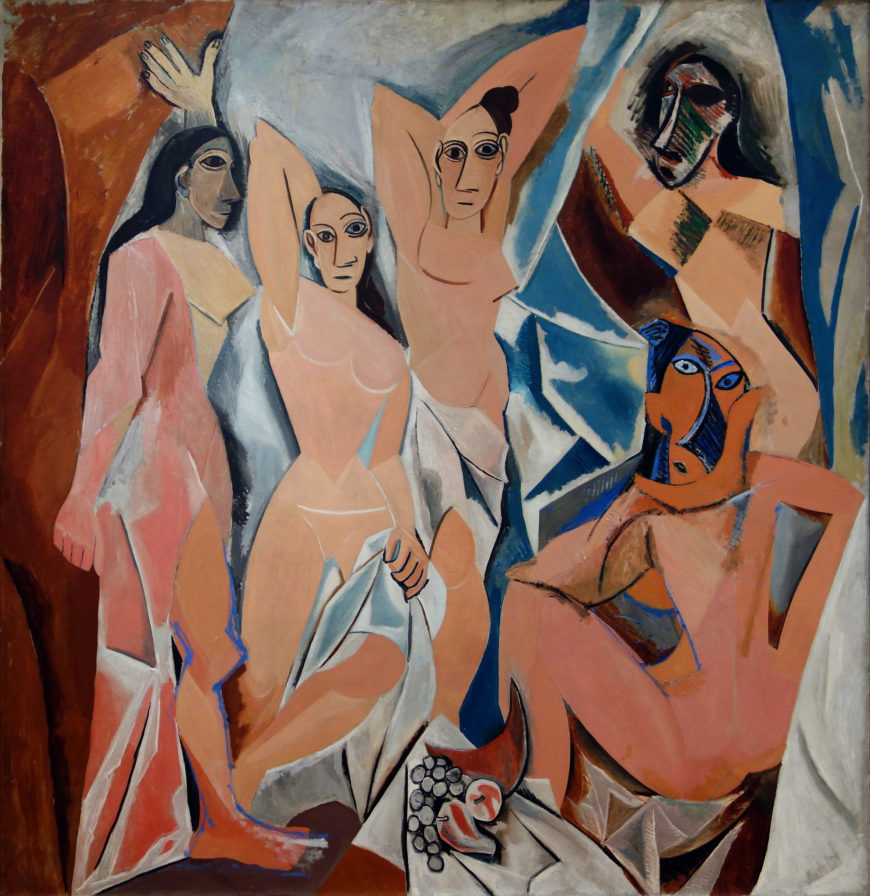
Pablo Picasso, Les Demoiselles d’Avignon, 1907, oil on canvas, 243.9 x 233.7 cm (The Museum of Modern Art, New York; photo: Steven Zucker, CC BY-NC-SA 2.0) © Estate of Pablo Picasso
Cézanne’s ghost, Matisse’s Bonheur de Vivre, and Picasso’s ego
One of the most well-known canvases of the 20th century, Pablo Picasso’s breakthrough painting Les Demoiselles d’Avignon was constructed in response to several significant sources.

Paul Cézanne, The Large Bathers, 1906, oil on canvas, 210.5 x 250.8 cm (The Philadelphia Museum of Art)
First amongst these was his confrontation with Paul Cézanne’s The Large Bathers at the posthumous retrospective mounted in Paris a year after the artist’s death in 1907.
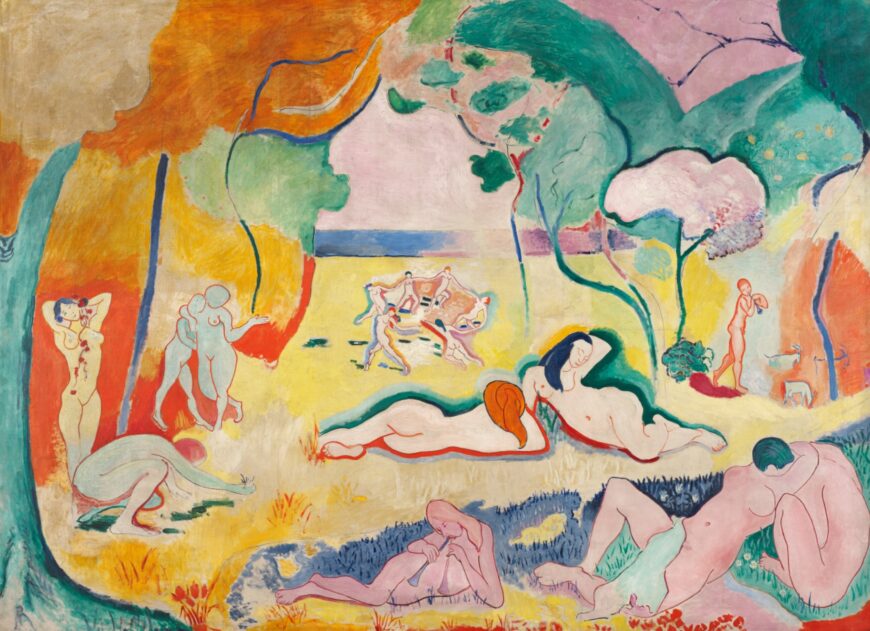
Henri Matisse, Bonheur de Vivre, 1906, oil on canvas, 175 x 241 cm (The Barnes Foundation, Philadelphia)
The retrospective exhibition forced the young Picasso, Henri Matisse, and many other artists to contend with the implications of Cézanne’s art. Matisse’s Bonheur de Vivre of 1906 was one of the first of many attempts to do so, and the newly completed work was quickly purchased by Leo & Gertrude Stein and hung in their living room so that all of their circle of avant-garde writers and artists could see and praise it. And praise it they did. Here was the promise of Cézanne fulfilled—and one which incorporated lessons learned from Georges Seurat and Vincent van Gogh, no less! This was just too much for the young Spaniard.
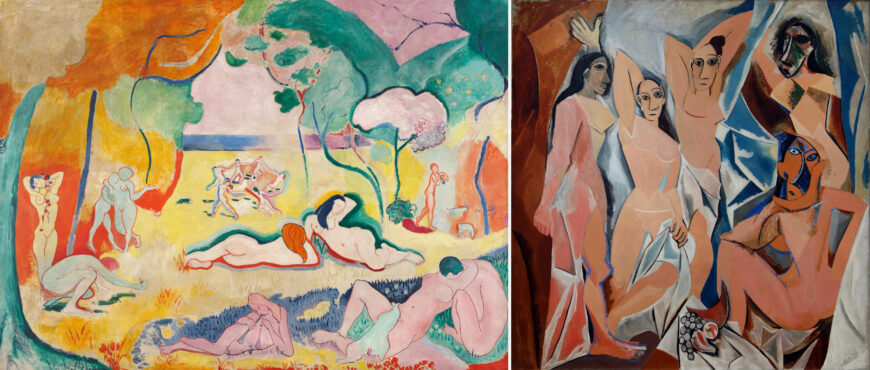
Left: Henri Matisse, Bonheur de Vivre, 1906, oil on canvas, 175 x 241 cm (The Barnes Foundation, Philadelphia); right: Pablo Picasso, Les Demoiselles d’Avignon, 1907, oil on canvas, 243.9 x 233.7 cm (The Museum of Modern Art, New York; photo: Steven Zucker, CC BY-NC-SA 2.0) © Estate of Pablo Picasso
Pablo becomes Picasso
By all accounts, Picasso’s intensely competitive nature literally forced him to outdo his great rival. Les Demoiselles D’Avignon is the result of this effort. Let’s compare canvases. Matisse’s landscape is a broad open field with a deep recessionary vista. The figures are uncrowded. They describe flowing arabesques that in turn relate to the forms of nature that surround them. Here is languid sensuality set in the mythic past of Greece’s golden age.
In very sharp contrast, Picasso, intent of making a name for himself (rather like the young Édouard Manet and Jacques-Louis David), has radically compressed the space of his canvas and replaced sensual eroticism with a kind of aggressively crude pornography. (Note, for example, the squatting figure at the lower right.) His space is interior, closed, and almost claustrophobic. Like Matisse’s later Blue Nude (itself a response to Les Demoiselles d’Avignon), the women fill the entire space and seem trapped within it. No longer set in a classical past, Picasso’s image is clearly of our time. Here are five sex workers from an actual brothel, located on a street named Avignon in the red-light district in Barcelona, the capital of Catalonia in northern Spain—a street, by the way, which Picasso had frequented.
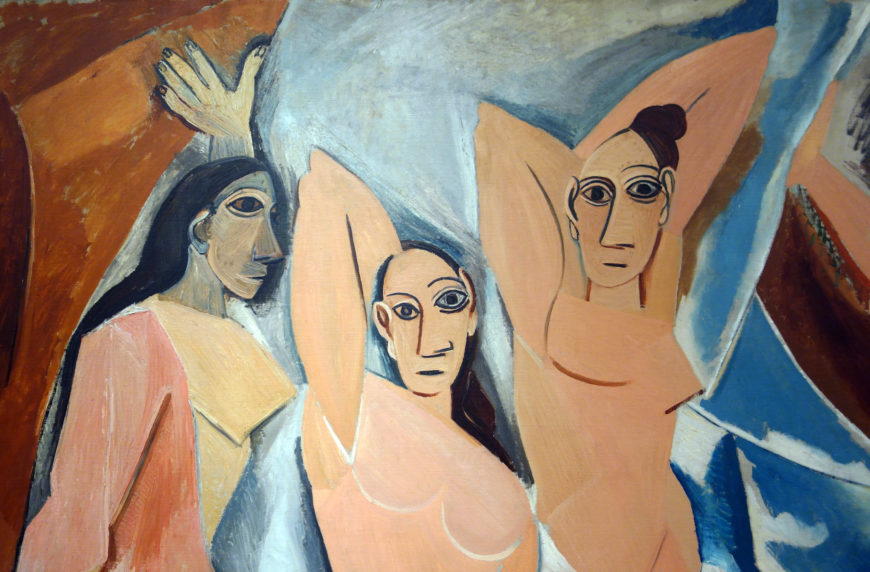
Bodies of three women (detail), Pablo Picasso, Les Demoiselles d’Avignon, 1907, oil on canvas, 243.9 x 233.7 cm (The Museum of Modern Art, New York; photo: Steven Zucker, CC BY-NC-SA 2.0) © Estate of Pablo Picasso
Picasso has also dispensed with Matisse’s clear, bright pigments. Instead, the artist chooses deeper tones befitting urban interior light. Gone too, is the sensuality that Matisse created. Picasso has replaced the graceful curves of Bonheur de Vivre with sharp, jagged, almost shattered forms. The bodies of Picasso’s women look dangerous as if they were formed of shards of broken glass. Matisse’s pleasure becomes Picasso’s apprehension. But while Picasso clearly aims to “outdo” Matisse, to take over as the most radical artist in Paris, he also acknowledges his debts. Compare the woman standing in the center of Picasso’s composition to the woman who stands with elbows raised at the extreme left of Matisse’s canvas: like a scholar citing a borrowed quotation, Picasso footnotes.
The creative vacuum-cleaner
Picasso draws on many other sources to construct Les Demoiselles D’Avignon. In fact, a number of artists stopped inviting him to their studio because he would so freely and successfully incorporate their ideas into his own work, often more successfully than the original artist. Indeed, Picasso has been likened to a “creative vacuum cleaner,” sucking up every new idea that he came across. While that analogy might be a little coarse, it is fair to say that he had an enormous creative appetite. One of several historical sources that Picasso pillaged is archaic art, demonstrated very clearly by the left-most figure of the painting, who stands stiffly on legs that look awkwardly locked at the knee. Her right arm juts down while her left arm seems dislocated (this arm is actually a vestige of a male figure that Picasso eventually removed). Her head is shown in perfect profile with large almond shaped eyes and a flat abstracted face. She almost looks Egyptian. In fact, Picasso has recently seen an exhibition of archaic Iberian sculpture at the Louvre. Instead of going back to the sensual myths of ancient Greece, Picasso is drawing on the real thing and doing so directly. By the way, Picasso purchased, from Guillaume Apollinaire’s secretary, two archaic Iberian heads that she had stolen from the Louvre! Some have suggested that they were taken at Picasso’s request. Years later Picasso would anonymously return them.
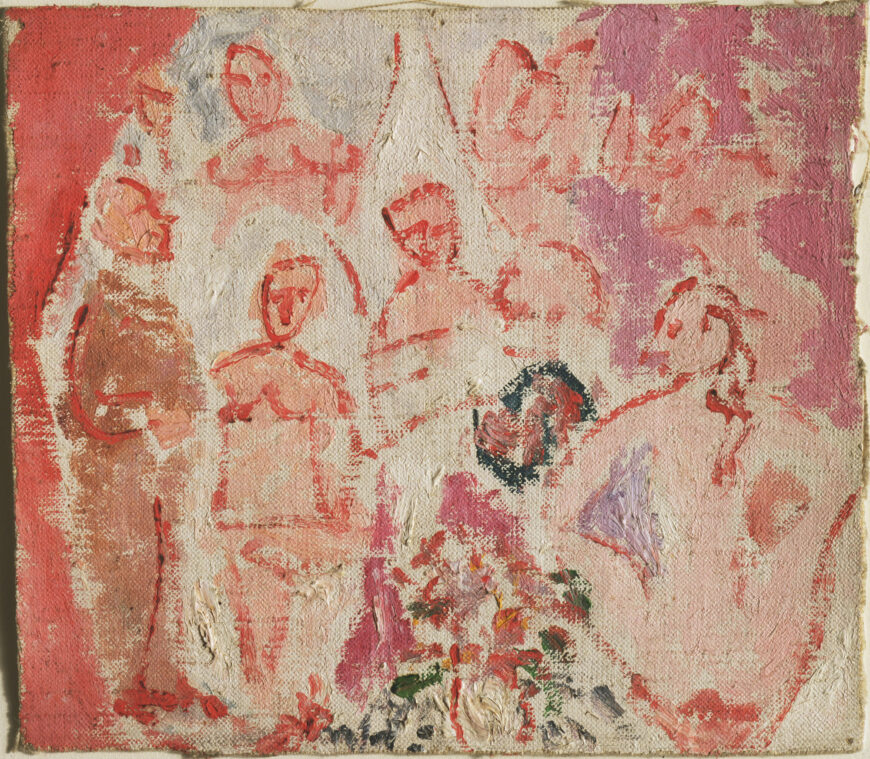
Pablo Picasso, Study for Les Demoiselles D’Avignon, 1907, oil on canvas, 18.5 x 20.3 cm (irregular) (The Museum of Modern Art, New York) © Estate of Pablo Picasso
Spontaneity, carefully choreographed
Because the canvas is roughly handled, it is often thought to be a spontaneous creation, conceived directly. This is not the case. It was preceded by nearly one hundred sketches. These studies depict different configurations. In some there are two men in addition to the women. One is a sailor. He sits in uniform in the center of the composition before a small table laden with fruit, a traditional symbol of sexuality. Another man originally entered from the left. He wore a brown suit and carried a textbook, he was meant to be a medical student.
The (male) artist’s gaze
Each of these male figures was meant to symbolize an aspect of Picasso. Or, more exactly, how Picasso viewed these women. The sailor is easy to figure out. The fictive sailor has been at sea for months, he is an obvious reference to pure sexual desire. The medical student is trickier. He is not there to look after the women’s health but he does see them with different eyes. While the sailor represents pure lust, the student sees the women from a more analytic perspective. He understands how their bodies are constructed, etc. Could it be that Picasso was expressing the ways that he saw these women? As objects of desire, yes, but also, with a knowledge of anatomy probably superior to many doctors. What is important is that Picasso decides to remove the men. Why? Well, to begin, we might imagine where the women focused their attention in the original composition. If men are present, the sex workers attend to them. By removing these men, the image is no longer self-contained. The women now peer outward, beyond the confines of the picture plane that ordinarily protect the viewer’s anonymity. If the women peer at us, like in Manet’s Olympia of 1863, we, as viewers, have become the customers. But this is the 20th century, not the 19th, and Picasso is attempting a vulgar directness that would make even Manet cringe.

Woman’s body (detail), Pablo Picasso, Les Demoiselles d’Avignon, 1907, oil on canvas, 243.9 x 233.7 cm (The Museum of Modern Art, New York; photo: Steven Zucker, CC BY-NC-SA 2.0) © Estate of Pablo Picasso
Picasso’s perception of space
So far, we have examined the middle figure which relates to Matisse’s canvas; the two masked figures on the right side who refer, by their aggression, to Picasso’s fear of disease; and, we have linked the left-most figure to archaic Iberian sculpture and Picasso’s attempt to elicit a sort of crude primitive directness. That leaves only one woman unaccounted for. This is the woman with her right elbow raised and her left hand on a sheet pulled across her left thigh. The table with fruit that had originally been placed at the groin of the sailor is no longer round, it has lengthened, sharpened, and has been lowered to the edge of the canvas. This table/phallus points to this last woman. Picasso’s meaning is clear, the still life of fruit on a table, this ancient symbol of sexuality, is the viewer’s erect penis and it points to the woman of our choice. Picasso was no feminist. In his vision, the viewer is male.
Although explicit, this imagery only points to the key issue. The woman that has been chosen is handled distinctly in terms of her relation to the surrounding space. Yes, more about space. Throughout the canvas, the women and the drapery (made of both curtains and sheets) are fractured and splintered. Here is Picasso’s response to Cézanne and Matisse. The women are neither before nor behind. As in Matisse’s Red Studio, which will be painted four years later, Picasso has begun to try to dissolve the figure/ground relationship. Now look at the woman that Picasso tells us we have chosen. Her legs are crossed and her hand rests behind her head, but although she seems to stand among the others, her position is really that of a figure that lies on her back. The problem is, we see her body perpendicular to our line of sight. Like Matisse and Cézanne before him, Picasso here renders two moments in time: as you may have figured out, we first look across at the row of women, and then we look down on to the sex worker of our/Picasso’s choice.
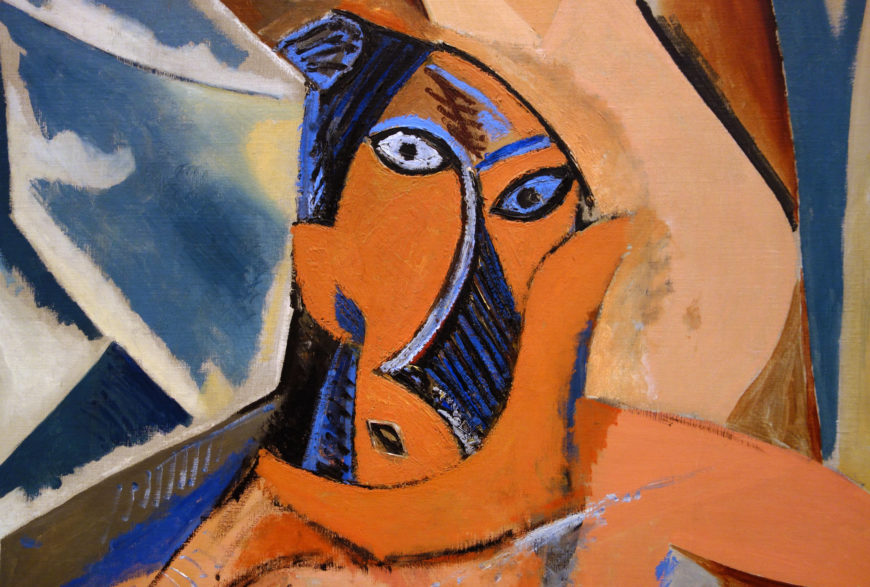
African mask (detail), Pablo Picasso, Les Demoiselles d’Avignon, 1907, oil on canvas, 243.9 x 233.7 cm (The Museum of Modern Art, New York; photo: Steven Zucker, CC BY-NC-SA 2.0) © Estate of Pablo Picasso
African masks, women colonized
The two figures at the right are the most aggressively abstracted with faces rendered as if they wear African masks. By 1907, when this painting was produced, Picasso had begun to collect such work. Even the striations that represent scarification is evident. Matisse and André Derain had a longer standing interest in such art, but Picasso said that it was only after wandering into the Palais du Trocadero, Paris’s ethnographic museum, that he understood the value of such art. Remember, France was a major colonial power in Africa in the 19th and 20th centuries. Much African art was ripped from its original geographic and artistic context and sold in Paris. Although Picasso would eventually become more sophisticated regarding the original uses and meaning of the non-Western art that he collected, in 1907 his interest was largely based on what he perceived as its alien and aggressive qualities.
William Rubin, once the senior curator of the department of painting and sculpture at The Museum of Modern Art, and a leading Picasso scholar, has written extensively about this painting. He has suggested that while the painting is clearly about desire (Picasso’s own), it is also an expression of his fear. [1] We have already established that Picasso frequented brothels at this time so his desire isn’t in question, but Rubin makes the case that this is only half the story. Les Demoiselles D’Avignon is also about Picasso’s intense fear … his dread of these women, or more to the point, the disease that he feared they would transmit to him. In the era before antibiotics, contracting syphilis was a well-founded fear. Of course, the plight of the women seems not to enter Picasso’s story.




